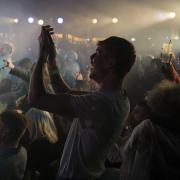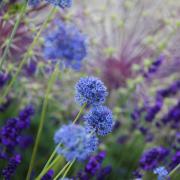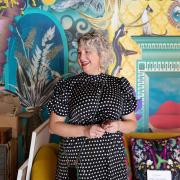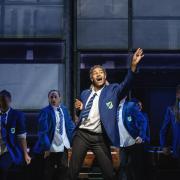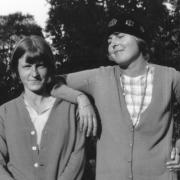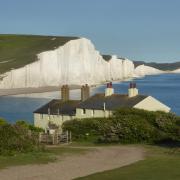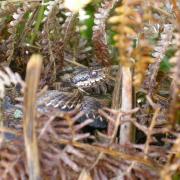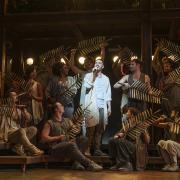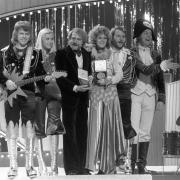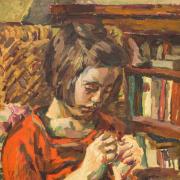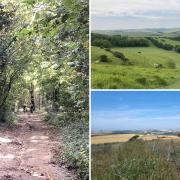Lord Gage is staging the first sale and public exhibition of his paintings at his ancestral home, Firle Place near Lewes, this summer. It offers a rare glimpse into the thoughts and feelings of this most private of men...
Lord Gage is staging the first sale and public exhibition of his paintings at his ancestral home, Firle Place near Lewes, this summer. It offers a rare glimpse into the thoughts and feelings of this most private of men. Angela Wintle meets the 8th Viscount and discovers why painting his birthplace has enabled him to exorcise a few ghosts.
Lord Gage is preparing to mount an exhibition of his paintings but has hit a snag. “Trouble is, if we hang my portraits in the Upstairs Drawing Room, it will mean taking down the Rubens,” he sighs. “And let’s face it, a Rubens is a Rubens!”
At the age of 75, Nicholas Gage, the 8th Viscount Gage, has decided to reveal a talent hitherto concealed from the outside world. In May, he will fling back the doors of the old laundry at Firle Place and invite the paying public to scrutinise his every brushmark. The paintings, all of them oils, will comprise a mixture of portraits and dream interpretations executed over the last decade. He also plans to include a selection of landscape paintings of his 15th century home.If truth be told, he’s a little apprehensive. “I’m not an artist, I’m a painter,” he tells me repeatedly, keen to make the distinction. Then he remembers that his wife, Lady Gage (Alex to her friends), has told him not to say that, so he clams up, before repeating it again 10 minutes later. Nicky as he is affectionately known, will blurt out such things. He just can’t help himself. Lord Gage is bouncier than when we last met eight years ago. Then, divorced from his first wife, he cut a slightly forlorn air. But now, recently married to Alexandra Templeton, 38, a senior fine art lecturer at the University of Brighton, and with a bonny seven-month-old son called John Valentine in tow, he is full of joie de vivre and eager to show off his latest work.“Come and see one of my dream paintings,” he says, showing me into a neighbouring room where a vast canvas is propped against the wall. He says it was inspired by a recent dream, prompted by an ambitious climb up Mount Ararat with his new wife. “I had shingles, but I got up to 14,000ft,” he says beaming. “I thought: ‘Mount Ararat... Of course, the Ark. Make a picture of it.” As you might expect, the canvas is populated by a vast menagerie – lions, zebras, giraffes, monkeys... Who’s the figure standing in the middle? “That’s Noah, redirecting the polar bears.”
He offers to show me another painting, deep in the bowels of the house. We start walking. Five minutes later, we’re still walking, past vast halls and along echoing corridors. But some people pay for this privilege, so I don’t complain. Eventually, we pitch up at a heavy oak door. He turns the lock and my gaze falls on a large canvas depicting an upmarket Kensington hat shop in which a naked lady is trying on a hat in a full-length mirror. Who’s the nude? I ask. “I don’t think I’ll tell you,” he mutters. “I had the idea after a visit to London. I hadn’t done my laces up properly and my shoe fell onto the railway line. So, what to do? Well, I carried on to London with one shoe. Nobody noticed. Or if they did, they thought it perfectly normal. And it got me thinking. Suppose there was a naked lady in a shop and everyone pretended not to notice. What might happen? It’s slightly erotic and surreal, don’t you think?”
Modest man of talentLord Gage came into his inheritance in 1993, after the premature death of his elder brother, George. He never expected to inherit Firle and occasionally feels like an imposter. “Firle has its own momentum and I think it would go on, irrespective of any Gage. I think of myself as a custodian. I don’t think anyone owns Firle. If you started moving pictures about, English Heritage would complain.”Firle Place, a magnificent 5,000 acre estate nestling in the Sussex Downs, has been in the Gage family for 500 years. The manor house, which opens to the public for three months of the year, was built in the late 1400s by Lord Gage’s ancestor, Sir John Gage, who was a Vice-Chamberlain to Henry VIII. It’s a magnificent spot, beloved of filmmakers. The BBC rolled up for a Jonathan Creek Christmas special some years ago and in 1981 Julie Christie walked the terraces for the film Return of the Soldier. One of its many striking features is its Caen stone cladding, intended to resemble a classic French chateau.
Ironically, it is this feature which Lord Gage found hardest to paint. “It’s impossible and changes every minute of the day,” he grimaces. He takes me to his studio, where Lady Gage has hung several canvasses for a recent private view. The results are surprising and rather moving. This modest man has a marked talent. The renowned artist Philip Hughes, who has written a short essay about the paintings, says they are remarkable, both in execution and intensity of observation. “What so impresses is that they encapsulate the myriad of detail of this complex architecture, without losing impact by any kind of photographic style,” he says. It’s certainly tempting to conclude that only someone with a deep connection to the house could have produced such works, though Lord Gage is typically matter of fact. “Firle is impossible to draw,” he frets. “It’s a complicated house and I’m not a natural draughtsman. But it would be mad, as I happen to live here, not to paint it. It’s there on the doorstep. And I really wanted to get Firle out of my system. Yes, I’m emotionally attached to the house, but mainly I saw it as a challenge. It was like exorcising a ghost. Now I can let go.”Lord Gage has been immersed in art from an early age, not least because old masters by Raphael and Van Dyck stared back at him from his living room walls. I imagine living with great masterpieces might be a mixed blessing. Inspirational, but deadening too. How could one ever match up?Acknowledging this point, Lord Gage shows me a magnificent landscape painting by the 17th-century Dutch artist Philip de Koninck. “Look at that. Who can do it? Every square inch is genius. One’s never going to be as good as that in a million years, but should that stop one from trying?”
Paintings speak for themselvesNot surprisingly, the Bloomsbury group – or, more specifically, the artists Vanessa Bell and Duncan Grant, who lived a few fields away at Charleston Farmhouse – have been another big influence. You can see traces of their style in Lord Gage’s painterly technique and use of colour.“I was once asked to lunch at Charleston when I was about 14. Vanessa Bell was quite intimidating, though I later got to know Duncan Grant much better. He was a conscientious objector and worked on the Firle estate during the First World War. I painted with him once or twice.”Mindful of his father’s wishes, Lord Gage pursued a career in the Coldstream Guards before eventually taking up farming. In his mid 30s, he attended the Byam Shaw School of Art in London and refined his technique at evening class. When he nervously unveiled his paintings at a private view at Firle earlier this year, he expected a critical mauling. “It was freezing winter and I thought no one would come, but by God they did. I think most people found it pleasurable. If it had been a failure, one would have known.”Artist Philip Hughes rates the work very highly. “All I can say is that it’s a shame it has taken so long for him to share it with us. The paintings speak for themselves. Here is a real artist. Show us more.”
The exhibition at Firle Place will open on May 22, 26 and 27, between 4pm and 7pm. The main opening season runs from June 2 until September 30 on Sundays, Wednesdays and Thursdays from 2pm until 4.15pm. It will also open on Bank Holiday Sundays and Mondays. 01273 858 307; www.firle.com



